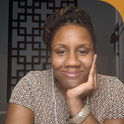
I teach probability and statistics at the high school level at a project-based, arts-integrated public charter school. At our school, we strive to make sure every student is “Known, Loved, and Inspired.” My work here has driven me to write and implement a curriculum that integrates statistics, storytelling, and social justice. The goal of this curriculum is to teach mathematics in a way that is accessible and equitable for all. This year, that included creating space for interreligious dialogue.
I give a “My Stats, My Story” assignment at the beginning of the school year. I use it to both introduce the subject of demographics and to get to know students a little better. I start by having students complete a basic form that asks their name, age, race, gender, zip code, and post-secondary plans. I present these to students as the most basic information that they will be asked on any application for a job, housing, credit, passport, etc. After completing the survey, we analyze the data we have collected as a class. Finally, I ask students to write a 1-3 paragraph introduction of themselves, highlighting those demographics (literally I asked the demographics be in bold) and telling their story beyond those basic facts.
This year, I noticed that a number of students chose to share their religion and religious beliefs in their story. Many of them discussed how their faith guided their behaviors and values, as well as influenced how they were perceived by others. It was then that I realized the need to give voice to those students within the classroom, and I began incorporating interreligious work into my course.
In the past, I have used storytelling to increase engagement and understanding in my statistics class. We use clips from the movie Amistad and the TV series Roots while studying statistics about the Transatlantic Slave Trade. We’ve had a griot portray historical figures such as Harriet Tubman and Mother Mary Lange while studying the Maryland Census of 1860. We’ve also had students tell the stories of victims of police brutality, such as Philando Castile, while studying the probability of police stops in Baltimore County. These stories make the statistics more relevant for students.
It is important to tell stories because they create learning opportunities that might not otherwise exist. All stories inherently contain morals, themes, and life lessons that students can learn from. Stories also aid in the retention of information. In other words, students remember stories.
My experience with storytelling through the lens of religion and relationship gave me the space and opportunity to think about how to bring more student voice and reflection into the mathematics classroom. There was one worksop in particular where our ICJS Teachers Fellowship looked at data from the Pew Research Center’s Religious Landscape Study. The data tells a story all by itself. Looking at the data for Baltimore allowed me to look at the city in a different light. The data we viewed tells the story of a highly diverse metropolitan area where the majority of citizens are at least fairly certain there is a God and have a frequent “feeling of spiritual peace and well being.” However, they feel common sense and reason guide their sense of right and wrong, and there isn’t always a clear standard of what is right and wrong. Looking at these responses, I can see the clear potential for connection and discussion about faith and beliefs.
Even further, the results of the study open up the conversation for critical analysis of both the statistics and the study. For example, the study shows that 3% of Baltimoreans identify as Jewish and 2% identify as Muslim. These results are beyond surprising considering the history of Jewish communities on the Westside of Baltimore and the growth of the Nation of Islam in Baltimore during the Civil Rights Movement. Results like these open the door to both discussing the history of religious communities in Baltimore and the importance of effective sampling and non-biased collection of data.
As a result of participating in the ICJS Teachers Fellowship, I have gained the confidence to advocate for interreligious content within my course. Many would argue that conversations like these do not belong in a statistics class. However, this fellowship has shown me not just the opportunity for, but the importance of having these conversations with students in every course. I now know that we should no longer compartmentalize the aspects of our identity that pertain to faith and hide them in the name of formal education and professionalism. Instead, we should teach the whole child, which includes faith and faith connections.
 ELainia Ross-Jones teaches statistics at City Neighbors High School and was a 2022-2023 ICJS Teachers Fellow. Learn more about the ICJS teacher programs for teachers here.
ELainia Ross-Jones teaches statistics at City Neighbors High School and was a 2022-2023 ICJS Teachers Fellow. Learn more about the ICJS teacher programs for teachers here.
Opinions expressed in blog posts by the ICJS Teacher Fellows are solely the author’s. ICJS welcomes a diversity of opinions and perspectives.